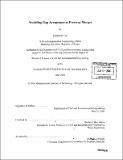Modeling gap acceptance at freeway merges
Author(s)
Lee, Gunwoo
DownloadFull printable version (7.701Mb)
Other Contributors
Massachusetts Institute of Technology. Dept. of Civil and Environmental Engineering.
Advisor
Moshe E. Ben-Akiva.
Terms of use
Metadata
Show full item recordAbstract
This thesis develops a merging model that captures the gap acceptance behavior of drivers that merge from a ramp into a congested freeway. Merging can be classified into three types: normal, forced and cooperative lane changing. The developed merging model uses a single critical gap function, which incorporates explanatory variables that capture all three types of merging behavior. Thus, the model combines all three types in a single model. The merging gap acceptance model is estimated using the maximum likelihood method with detailed trajectory data that was collected on two freeway sections in California. Estimation results show that the merging gap acceptance model is affected by traffic conditions such as average speed in the mainline, interactions with lead and lag vehicles, and urgency of the merge. Transferability tests for the stability of the model parameters between the two datasets are conducted. The single level gap acceptance model is implemented and compared with an existing gap acceptance model in the microscopic traffic simulation model, MITSIMLab. The results show that the proposed model is better than the existing gap acceptance model.
Description
Thesis (S.M.)--Massachusetts Institute of Technology, Dept. of Civil and Environmental Engineering, 2006. Includes bibliographical references (p. 103-105).
Date issued
2006Department
Massachusetts Institute of Technology. Department of Civil and Environmental EngineeringPublisher
Massachusetts Institute of Technology
Keywords
Civil and Environmental Engineering.